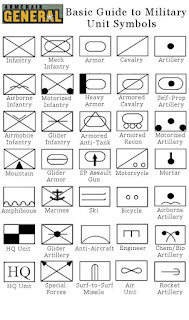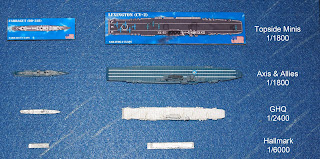The main types of block I currently use. These will be expanded by some additional types, primarily for the modern period.
There is a throwaway comment that is frequently used by the denizens of SEEMS which has assumed almost cult-like status. Describing something on the gaming table as being "purely representational" and delivered whilst dripping in irony, usually occurs at least once per game in my experience and it is guaranteed to generate rolled eyes and a modest chuckle or two. It is however, an expression that has within our wargaming world a far deeper significance than being a mere jest.
As wargamers we routinely represent military formations with 'x' number of models or figures. These are linked with whatever rule set is in use and so there is usually a figure scale so that a single model soldier will represent an certain number of their historical counterparts. This can vary hugely from 1:1 for a skirmish game up to, well, any number you like really. For the purposes of this post let us work on the basis of around 1:25. A 600 man battalion will be represented then by 24 model soldiers. Multiply that by a dozen and you have a representation of a good sized division with usually some cavalry and artillery to taste.
Once assembled, and in the company of a like minded acquaintance the models are deployed on a table top with some items of terrain and battle is joined. A few hours later a decision or 'life' intervenes, the models and terrain are packed away and the game discussed over a cup of tea or something stronger.
So what has taken place? A game of war for sure, but what exactly was being represented? In this rather obvious case, a divisional level battle. At this point I feel obliged to ask - how many gamers know of any 'pure' divisional level battles fought during the horse and musket period? I intended this as a rhetorical question and for what it is worth I have absolutely no idea what the answer is although I am sure that there were some!
We could take the above battle further in that player A and B called their respective forces 'armies' and so the dozen battalions could be viewed as representing larger components than the number of figures would indicate. How many of us I wonder, have said "Right, those two battalions represent the brigade/division of General 'X'? Quite a few I reckon.
Straightaway this perfectly natural solution to the eternal problem of space and enough figures has the effect of skewing anything that approximates to a ground or figure scale. But the units mentioned in the previous paragraph will still look like two twenty four figure units - or in other words will still be purely representational!
The point I am trying to get to here is that using model soldiers to fight wargames is absolutely fine but let us not kid ourselves that by doing so we are accurately representing the art of war in miniature. What we are doing is playing a game based on our understanding of war that is in effect a kind of movable diorama or, dare I say it, something that is purely representational. I am as guilty as the next person for doing this and will continue to do so because, quite simply, as a hobby, a game of war using model soldiers is, to quote Messrs. Young and Lawford, "....a magnificent indoor sport."
However, for the grand scale of what I want to represent using figures is not the solution I am looking for.
It will probably some as no surprise as to what I am going to mention next. That's right. Blocks - or as my good friend Mr Fox once drily observed, "A load of Blocks...."
An earlier version of modern vehicle labels available in three colours. I was pleased with the way the drawings came out but opted instead to stick with military symbols.
My fondness for using wooden blocks featuring labels using common military map symbols is well known but I want to point out the advantages of using them, practical and otherwise.
As students of military history looking at maps of great battles and campaigns are almost obligatory. A well drawn map that is clear and ably supported by a relevant narrative can really serve to place the gamer in the shoes of the commander in question. The flip side of this is where the map is poor and the narrative is vague - and I feel quite sure that any reader of this blog will have experienced both extremes during their own research into their own particular period of interest!
The symbols employed on most maps are fairly standard and the core types mainly originated during the 19th century and were 'formalised' by the US during the Great War. The saltire in a rectangle represents the cross belts of an infantryman; the diagonal line represents the sabre belt of the cavalryman whilst the single round spot is the muzzle of a cannon. These are the standard types and of course these can be expanded upon within the same generic type to represent specialists. The one thing they do not represent though, at least in the way I have fashioned my own collection, is the size of the formation the block represents.
The most usual way to indicate the size of formation represented by a single symbol drawn on a map is to add a series of crosses onto the leading or top edge of the unit. The number of crosses represents the level of formation so, for example, a single cross may refer to a battalion, two crosses a brigade and so on. The key thing is with this method is the importance of having a guide to the sizes of the formations being represented so most books that feature military maps will routinely have a legend explaining what means what.
For my own purposes and, it must be said, quite by accident the block collection I have built can be used for any scale of formation by the simple expedient of recording on a roster what the level the formation represents. So three infantry blocks would be equally at home being used as platoons or anything up to a corps, obviously with the appropriate additional blocks for support types - cavalry and artillery for example.
The end result of this is that I can use them for any size of action - with no loss of visual effect - by merely adjusting the emphasis of the rules and terrain being used - a couple of buildings at platoon level represents just that whilst further up the hierarchy a single building may represent an entire town or even city (actually this raises a similar problem to using figures but that is for another post!).
Another early block battle and for some reason I never saved this to the Games folder. This was fought on November the 11th 2011 and featured those old combatants Fezia and Rusland
I have demonstrated to my satisfaction that the use of blocks to fight wargames is a viable alternative to using figures and indeed there are certainly a number of practical advantages. To begin with making a couple of sets is a very simple undertaking. Storage is very easy and the size of the blocks is such that scenery from 15mm downwards can be readily used. This point is very important as it means that a 6ft by 4ft table can represent a good sized area to fight over when running a large scale or army level game. Finally, by careful choice of colour schemes one can use block armies for a variety of periods and as a good example of this my red set can and has been used for actions fought across the entire time span that the British army wore the redcoat. I should also add the point that the use of blocks have a long and distinguished history when used for wargames from Kriegspiel onward.
I enjoy the flexibility that using the blocks gives me and when used with 3D terrain it really brings a gaming battlefield to life but in order to make the most of them there needs to be disciplined approach. As mentioned earlier any supporting narrative needs to be clear so that the action is more readily understandable. It also means that easy unit identification is important - more so as unlike with figures you cannot rely on looking at the facing colours or standards of a block to see who they are.
I shall be developing the block armies over the next year to take the collection to the next level. It will mean changing some and producing newer types as well as addressing the unit identification issue. I shall be fighting both on and off a grid based playing surface and at all levels from platoon actions up to army level battles. It also means that I shall be looking long and hard at rule systems to support this evolving project, both from existing sets and from my own efforts.
I was mildly surprised to read the answer below I posted in response to a blog comment from
09/12/13 - just over five years ago.
"
Many thanks for your kind words - they are much appreciated. I must confess that the visual success of the blocks I am using has really made think long and hard about whether or not I need to use figures ever again! The designs I have used have evolved over time and the biggest difficulty I experienced was whether or not to use images of the troops or the military symbols. I am so pleased that I stuck with the latter as it seems to add to the flexibility of the collection - which is an important consideration for one who has such wide-ranging interests!"
Prophetic words indeed!
It will probably come as no surprise to learn that I am currently undertaking the ground work to produce a book on wargaming using blocks and other alternatives to figures and this will be the big project for next year.
From the figures perspective my efforts will be directed at the Kurz and Allison Spencer Smith ACW project with the two forces based on the organisation featured in Charge! by the aforementioned Messrs. Young and Lawford. I am looking forward to this as it is being undertaken with a specific look and aim in mind. I have not abandoned using figures by any means but for the most part what I want to do I can tackle far more easily using blocks. After all, one has to maintain one's hobby safely in the actual purely representational figure world rather than relying on the exclusively purely representational block world.

































